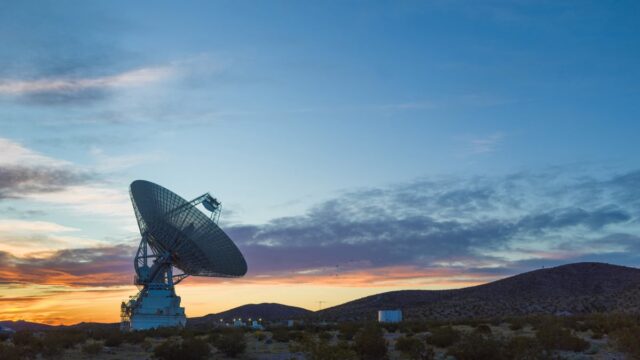Equipment failures in NASA‘s Deep Space Network have disrupted spacecraft communications and stalled near-Earth asteroid studies for nearly two months.
As the federal government remains shut down, engineers are racing to restore the space agency’s historic 230-foot-wide radio dish near Barstow, Calif. The massive dish, about the size of a Boeing 747 jet, broke down on Sept. 16.
Known since 1966 as the Mars Antenna for receiving the first signals from a spacecraft closely observing the Red Planet, the giant dish over-rotated during operations, straining cables and pipes at its center. Damaged hoses from the fire suppression system also caused flooding, though the water damage was quickly abated, according to NASA in a statement to Mashable.
NASA has established a formal mishap investigation board to examine what led to the antenna’s damage.
“The antenna remains offline as the board members, engineers, and technicians evaluate the structure and make recommendations and repairs,” said Ian O’Neill, a NASA Jet Propulsion Laboratory spokesperson. “There is no danger to the public.”
Due to the shutdown, NASA employees could not respond to questions for weeks. But as a Senate vote signaled progress toward reopening the government, the agency began providing limited information to Mashable’s inquiry.
The repair timeline remains unclear, leaving open the question of how the outage may affect preparations for Artemis II, a 10-day crewed mission that will orbit the moon as early as next year. Its predecessor, Artemis I, needed more than 900 hours of Deep Space Network support in 2022 and briefly lost contact during flight, underscoring the system’s fragility.
Mashable Light Speed
Founded in 1963, NASA’s Deep Space Network is the world’s largest and most powerful system for communicating with spacecraft. It commands and monitors more than 40 missions, with more on the way. The network’s three antenna complexes — in California, Spain, and Australia — work around the clock so that at least one site can always reach spacecraft as Earth turns.
Upon the network’s 50th anniversary in 2013, Al Bhanji, who used to manage it, explained how crucial the system had been for practically everything NASA had undertaken in space.
“Without the DSN, we would never have been able to undertake voyages to Mercury and Venus, visit asteroids and comets,” Bhanji said then. “We’d never have seen the stunning images of robots on Mars, or close-up views of the majestic rings of Saturn.”
It’s no secret in the aerospace community that the network is overburdened. The NASA inspector general, who acts as the federal watchdog over the agency, has pressed for upgrades to the aging infrastructure. Over the past 30 years, data flowing through it has increased sharply, exceeding what the system was built to handle by 40 percent. Under NASA’s Deep Space Network Aperture Enhancement Program, the agency is adding six dishes, including a new 112-foot-wide antenna in California slated to go online in 2026.
The damaged Mars Antenna is the largest dish at the Goldstone Complex in California, capable of tracking spacecraft traveling tens of billions of miles from Earth. It was expanded to its current size in 1988 to support the Voyager 2 mission, which has since exited the solar system, along with Voyager 1.
As the world’s most sensitive planetary radar, the dish is also used to “ping” near-Earth asteroids. This allows scientists to determine an asteroid’s position and speed, giving them the ability to estimate a rock’s trajectory, crucial for tracking asteroids that could potentially slam into Earth. Researchers can also use the radar to “image” the objects. Though most asteroids are studied with optical telescopes, radar images can provide information about the physical properties of the rocks, like their shapes and sizes.

Under NASA’s Deep Space Network Aperture Enhancement Program, the agency is adding six dishes, including a new 112-foot-wide antenna in California slated to go online in 2026.
Credit: NASA / JPL-Caltech
After the Arecibo Observatory in Puerto Rico collapsed in 2020, the NASA dish ramped up its radio astronomy to fill the void. Since then, the Mars Antenna has detected over 200 near-Earth asteroids. At the end of last year, more than half had been classified as “potentially hazardous.”
It’s uncertain how long the antenna will remain out of service, but all of its scheduled asteroid observations have been canceled at least through the end of this year.
“NASA will provide information on the board’s findings and next steps to the antenna’s service after the federal government reopens,” a spokesperson said.
Though failures in the network of this kind are rare, the legendary antenna in the Mojave desert has survived setbacks in the past. In 2014, a welder accidentally dropped a handrail while conducting maintenance, for example, puncturing a hole in the dish. In 1992, a magnitude-7.4 earthquake also damaged the antenna, requiring repairs.








